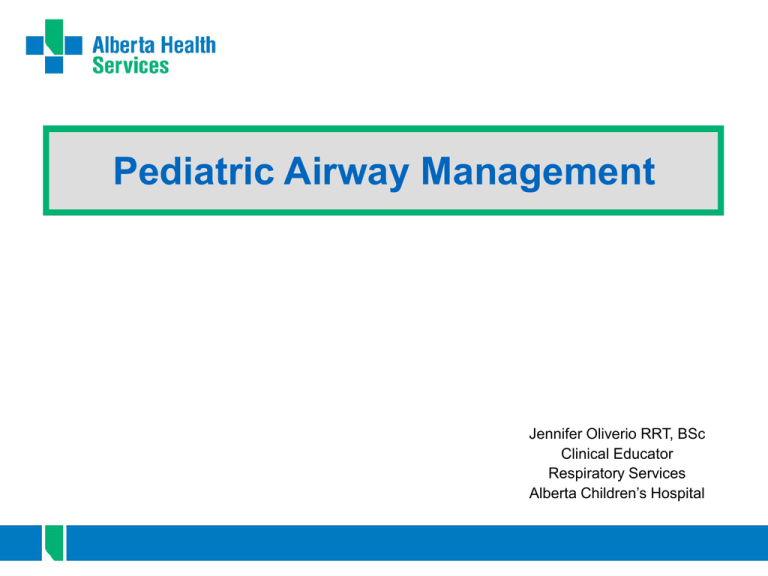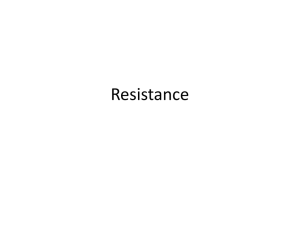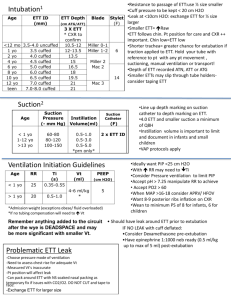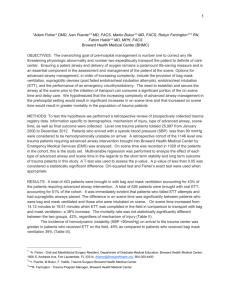Pediatric Airway Management
advertisement

Pediatric Airway Management Jennifer Oliverio RRT, BSc Clinical Educator Respiratory Services Alberta Children’s Hospital A & P Characteristics of Newborn Respiratory System • Infant lung is a unique structure not a mini- adult lung • Airways, distal lung tissue and pulmonary capillary bed continue to grow and develop after birth • General pattern is laid down at birth but upper and lower airways continue to change • Alveoli development complete and adult anatomy by 810 years of age • Ossification of ribs and sternum complete by 25 years of age 2 Nose • Obligatory nasal breathing • Poor tolerance to obstruction Tongue • Relatively Large • Neck extension may not relieve obstruction 3 Head • Relatively large • Anterior flexion may cause airway obstruction Epiglottis • Relatively large and U- shaped • More susceptible to trauma • Forms more acute angle with vocal cords 4 Larynx • More anterior and cephalad • Intubation more difficult Cricoid • Narrowest portion of airway • ↑ resistance with airway edema or infection • Acts as “cuff” during tracheal intubation 5 Trachea • Small diameter (6mm), high compliance • ↑ resistance with airway edema or infection • Collapses easily with neck hyperflexion or hyperextension Alveoli • ↑ closing capacity • No pores of Kohn • ↑ air trapping and ↓ collateral circulation of air 6 Pulmonary Vessels • ↑ pulmonary vascular resistance (PVR) • Very sensitive to constriction by hypoxia, acidosis and hypercarbia Chest Wall • • • • • • ↑ compliance due to weak rib cage ↑ A-P diameter Horizontal ribs Breathing is all diaphragmatic FRC determined solely by elastic recoil of lungs Chest wall collapses with -ve pressures 7 WOB • Weak resp muscles • ↑ RR = early sign of resp distress Regulation of Breathing • Response to ↓ O2/ ↑ CO2 minimal • Tolerates hypoxia poorly 8 Airway assessment • Best to 1st look from afar. Infants and small children don’t like strangers hard to assess baseline after they are upset. • Is the chest moving? • Can you hear breath sounds? • Are there any abnormal airway sounds (e.g.. Stridor, snoring)? • Is there increased respiratory effort with retractions or respiratory effort with no airway or breath sounds? 9 Airway Management • Simple things to improve airway patency • Suction nose and oropharynx • Reposition child/ allow child to assume position of comfort • head-tilt-chin lift/ jaw thrust • Use airway adjuncts- NPA/ OPA 10 Oral & Nasopharyngeal Suctioning • Clean technique • Negative pressure of 80 to 120 mmHg. Test suction level on regulator prior to suctioning • Nasal and oral suction can be performed with same catheter • May result in hypoxia, ↓ HR (vagal), bronchospasm, larygospasm, atelectasis 11 Suction supplies • • • • Clean gloves Suction regulator, canister, tubing Normal saline in cup Yankauer and appropriate suction catheter Neonates 5-6 Fr Infants 6-8 Fr Older kids 10 Fr 12 Nasopharyngeal Suction • Measure length from pt’s earlobe to tip of nose • Keep pass <10 sec. • Document: pt assessment prior to procedure, time of procedure, amount and type of secretions, pt’s response 13 Positionning • If pt has preferred position let them remain in that position e.g. tripod • Repositioning can greatly improve airway patency • Manual airway maneuvers can also help open the airway (head tilt-chin lift/ jaw thrust) 14 Oral Pharyngeal Airways (OPA) • Only for use in UNCONSCIOUS pt with no intact cough/gag reflex • Holds tongue and soft hypopharyngeal structures away from posterior pharynx • Still need good head and jaw position to maintain airway patency • Suction airway prn • Never tape in place 15 Choosing correct OPA • Place OPA against side of face. With flange at the corner of the mouth the tip should reach angle of the jaw • Too small: will not adequately displace tongue • Too large: may obstruct larynx and/ or interfere with mask fit if BVM required 16 17 Nasopharyngeal Airways • Soft plastic pre-made or shortened ETT • Provides unobstructed path for airflow between nares and pharynx • Can use in conscious/ semi-conscious pt • Small internal diameter so must be evaluated frequently and suctioned prn to maintain patency 18 19 If these don’t work… • Pt may require more advanced interventions to establish a patent airway • CPAP • Intubation 20 Breathing • • • • • RR Effort Tidal volume Airway and lung sounds SpO2 21 RR • Normals As per PALS Age BPM Infant (<1 yr) 30-60 Toddler (1-3) 24-40 Preschool (4-5) 22-34 School age (6-12) 18-30 Adolescent(13-18) 12-16 22 RR • Best to evaluate prior to hands-on assessment • Excitement, anxiety, exercise, pain, fever, agitation can all ↑ RR • ↓ RR with acutely ill child or with ↓ LOC = ++ cause for concern • > 60 in any age is cause for concern 23 Effort • Signs of ↑’d respiratory Effort – Nasal flaring – Chest retractions – Head bobbing • Chin lifts and neck extends during I • Chin falls forward during E – Seesaw respirations • Chest retracts and abdomen expands during I, reversed during E • Very Inefficient= quickly leads to fatigue – Grunting • Child exhales vs partially closed glottis in an effort to keep small airways open 24 Auscultation • Same landmarking and principals as with adults • BUT…smaller size and sound is transmitted much more easily throughout the infant chest. 25 Bag-Mask Ventilation • Indicated when the pt’s spontaneous breathing effort is inadequate despite patent airway • Can provide adequate oxygenation and ventilation until definitive airway control is obtained • Can be as effective as ventilation through ETT 26 **Multiple Mask sizes available so choose the correct one** 27 Bagging Units • 3 sizes: Age Volume (ml) Infant 500 Child 1000 Adolescent 2000 28 Testing the bagging unit • Check all components before use to ensure proper function. Ideally as part of your daily safety checks. • Occlude pt outlet and outflow, squeeze bag ensure no tears/leaks • Check that PEEP valve works (2L) • Ensure connection to wall O2 and adequate flow • Proper size mask with cuff inflated 29 Bagging 1. Position pt: sniffing position 30 Infants: Want exterior ear canal to be anterior to the shoulder In our experience at ACH we find a shoulder roll works best for positioning infants and small children 31 Bagging 1. 2. Position pt: sniffing position Open airway and seal mask to face using E-C technique. You may need OPA. 32 33 Bagging 1. 2. 3. Position pt: sniffing position Open airway and seal mask to face using E-C technique. You may need OPA. Squeeze bag with other hand to deliver tidal volume and produce chest rise. Careful to not over-ventilate! 34 2 person BMV • One person uses both hands to open airway and maintain tight mask-to-face seal • 2nd person bags 35 Monitor effectiveness of Ventilation • • • • • • • Visible chest rise with each breath SpO2 ETCO2 HR BP Pt responsiveness Air entry on auscultation 36 If ventilation is not effective… • • • • • • Reposition pt. Reposition airway. OPA. Verify proper mask size and placement Suction airway Check O2 source and flow Check bag and mask for function/leaks Treat gastric inflation 37 Indications for intubation • • • • Respiratory distress Apnea Self-extubation Upper airway obstruction or the potential to develop upper airway obstruction • Actual or potential decrease in airway protection (compromised neurological function) • Need to eliminate/ reduce WOB (e.g. cardiac pt) • Inadequate ventilation and/or oxygenation 38 Preparing for Intubation • Appropriate ETT for >1 yo: (age/4) + 4 Term infant: 3.0-3.5 ID 6 mo: 3.5-4.0 ID 1 yo: 4.0-4.5 ID • Cuffed ETT’s for pt’s > 8 yo • If you anticipate need for high PEEP or PIP may want to use cuffed ETT with <8 yo. Use ½ size smaller ETT. • Remember SOAPME 39 SOAPME Suction equipment: yaunkauer, catheters, regulator/canister/tubing, Oxygen: O2 flowmeter, preoxygenate 2-3 min, manual resuscitator bag with mask Airway equipment: ETT, stylet, syringe (cuffed ETT), laryngoscope and blade, lubricating gel, OPA Position, pharmacy, personnel: supine, rolls for positioning, bed height up Monitors ETCO2 detector 40 Post-Intubation • • • • • • ETCO2 assessment for confirmation of placement Auscultation for bilateral air entry Placement of ETT documented ETT secured with tapes CXR to confirm placement Place pt on ventilator 41 Acute deterioration post-intubation • Remember DOPE D Displaced ETT ETT may be in trachea or in right or left mainstem bronchus O Obstruction of ETT Secretions, blood, pus, foreign body, kinked ETT P Pneumothorax Simple Tension E Equipment failure Disconnection of O2 source, leak in vent circuit, loss of power/ vent malfunction 42 Tube Position • Remember: Endotracheal tube position follows chin • Pt positioning ++ important. Often need shoulder roll to keep chin neutral. • CXR need to be done with neutral, midline head position (RRT should be called) – Chin low- tube low – Chin high- tube high 43 Uncuffed ETT’s • May have issues with leak • Better success with Pressure modes of ventilation with a tube leak • Position of pt can affect amount of leak • If having difficulty with ventilation or oxygenation may need to upsize ETT or Δ to cuffed ETT • Short term fix: NS soaked nasal packing packed around ETT. DO NOT CUT the gauze. 44 Cuffed ETT • Important to assess cuff inflation Qshift • > 8 yo can follow adult VAP guidelines • 25-30 cm H2O inflation pressure • < 8 yo MOV with pressure < 20 cm H2O often quite a bit lower than 20 • Cuff is circumferential in a growing airway! 45 Suctioning ETT • Suction frequency depends on ETT size and pt needs: • 4.0 i.d. and smaller- a minimum of Q8H unless • otherwise ordered • 4.5 i.d. and greater- prn or as ordered • All pt’s need for suction should be assessed hourly and prn Sterile suctioning Suction depth should only be 0.5 cm past the end of ETT • Determine suction depth by using suction guide or match number on catheter to number on ETT and advance 0.5 cm. 46 Assessing need for suction • Clinical assessment of pt will determine frequency of suctioning. Many factors influence the need for suction including but not limited to: – ETT Size – Changes in vital signs – Adventitious breath sounds – ↓ breath sounds/ chest movement – ↓ SpO2 – Visible secretions in ETT – Respiratory distress – Coughing – ↑TcCO2/ EtCO2 – ↑ PIP – Worsening ABG/CBG 47 Selecting suction catheter • Use largest size that can pass easily down the ETT • Ideally not larger than half the diameter of ETT to avoid causing atelectasis • TIP: choose double the ETT e.g. 4.0 i.d. ETT choose 8 Fr suction catheter 48 Wall suction Use lowest possible setting Age negative pressure (mmHg) < 1 yo 60-80 1-12 yo 80-120 13-17 yo 100-150 49 Instillation • Normal saline unless otherwise ordered • Should occur prn not routinely • For <10 FR you can use sterile NS syringe as there is no oneway valve in instillation port. For >12 Fr you will need pink NS nebule. • Recommended amounts: Age Volume < 1 yo* 0.5-1.0 mL 1-12 yo 0.5-3.0 mL 13-18 yo 0.5-5.0 mL *total volume is especially important to limit and document in infants and small children 50 Suction Guide • Should be filled out at the bedside for all ETT < 4.5 and all pediatric tracheostomy pt’s regardless of tube size • Suction ½ cm farther than marked length to clear end of ETT unless otherwise ordered (e.g. TEF repair) 51 Closed Suction 52 53 Patient Preparation • • • • • • Assess pt visually and auscultate, note monitor readings Determine need for sedation/ analgesia Ensure ETT tapes are secure Explain procedure to pt/ parents Pre- oxygenate and give meds as required Position pt 54 Closed Suction • Ensure suction is on and set appropriately • Ensure bagging unit attached to O2, adequate flow, and intact • Attach sterile syringe with appropriate instillation solution to instillation port • Securely hold ETT with one hand and insert catheter to appropriate depth with the other • Apply continuous suction while slowly withdrawing the catheter • Flush catheter by instilling into instillation port while applying suction • Allow pt to re-oxygenate at least 30 sec between passes 55 Post-Suctioning • • • • • Turn suction control to locked position Remove instillation syringe and cap instillation port Disconnect suction tubing and cap end Reasess pt Document: – Time – Initial assessment – Amount of suctioning required – Amount and type of secretions – Amount and type of instillation – Pt response 56



